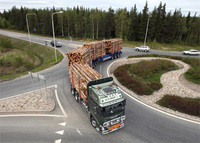Transport efficiency improvements require better co-ordination

Demand for freight haulage in Europe continues to rise, increasing the burden on both the climate and traffic flows. According to the EU, transport must be made more efficient to better meet increased demand and this requires enhanced interaction between different modes of transport. According to Swedish truck manufacturer Volvo Trucks, the solution lies in increased use of standardised load carriers.
The large amounts of traffic on European roads are causing ever bigger problems. Every day, tailbacks disrupt the traffic flow along 7,500 kilometres of roadway in and around European cities – that is almost 10 per cent of the entire continent’s road network.
The EU Commission estimates the cost of these bottlenecks at more than €80 billion (£71 bn) annually - and that does not take into account the environmental aspect. Bearing in mind that the transport sector accounts for about 27 per cent of the 4,500 million or so tonnes of carbon dioxide discharged every year, it is clear that Europe has a growing problem to deal with.
Between 1995 and 2006, goods freight grew by a total of more than three per cent annually. However, most of this volume increase was on roads, contributing to the fact that road transport now accounts for almost 50 per cent of all goods transport in the EU.
“There is no doubt that additional efforts must be made to solve Europe’s traffic problems,” says Nam Seok Kim, transport analyst at South Korea’s Transport Institute (KOTI), who has recently completed a doctorate on combined freight systems in Europe and is thoroughly familiar with every aspect of the continent’s traffic situation.
“The problem is that the steady growth in freight traffic is not occurring symmetrically across all traffic types,” he says, adding “so the crucial question is, who should deal with the problem ?”
To balance the situation, the EU has financed a number of initiatives designed to stimulate the development of so-called intermodal transport – using a combination of trains, ships and trucks to transport goods throughout Europe.
“The EU and the member states’ governments can build roads and infrastructure, but problems concerning commercial transport must be solved through private initiatives,” explains Nam Seok Kim.
For several years, Volvo Trucks has conducted a project called EMS (European Modular System) which focuses on increased use of standardised load carriers such as exchangeable bodies and semitrailers as well as 20- and 40-foot containers to simplify integration between different traffic modes. The system is based on the 25.25 metre truck combinations that have long been in use in both Sweden and Finland.
“We are lobbying hard for the EU to adopt 25.25 metre combinations in continental Europe too, since this would permit increased use of standardised load carriers and thus stimulate the growth of intermodal transports,” explains Ulf Ehrning, transport analyst at Volvo 3P, Volvo Trucks’ development company.
He explains that the current focus is on evaluating the EMS tests recently conducted in the Netherlands and Denmark, and soon it will be time for Germany to test the system. However, critics claim that modular vehicles will steal freight from the railways.
“There is absolutely no conflict between longer trucks and rail or sea freight,” says Stefan Back, Chairman of the Road Transport Institute, CLECAT’s working group for road haulage. He continues “Modular vehicles are tailor-made for intermodal transport; their freight-carrying units can be transported by rail and by sea. There is absolutely no reason to pitch the various transport modes against one another. Instead, the focus should be on ensuring that they can develop both individually and together.”
Stefan Back also feels that modular vehicles would help ease the pressure on Europe’s overloaded road network. “With longer truck combinations, two 25.25 metre combinations can replace three conventional 18.75 metre rigs,” he says.
Volvo Trucks also runs its own tests on modular transport. For instance, the company has been testing 90-tonne 30 metre long timber haulers in regular operation in northern Sweden.
“Our tests show a 20 per cent fuel saving per ton-kilometre by switching from regular, European 16.5 or 18.75 metre rigs to 25.25 metre combinations. And, if you step up to 30 metre long rigs, you save as much again,” says Ulf Ehrning.

